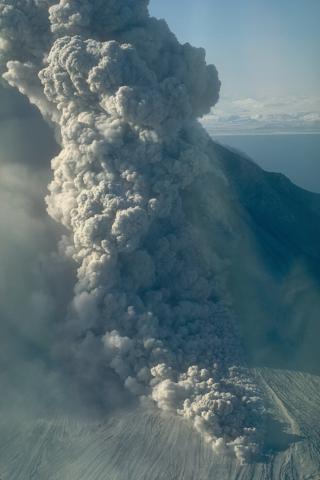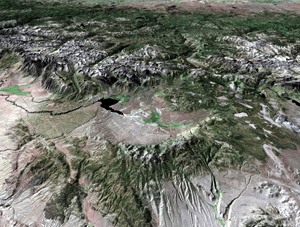








Silicic Magmatism and Volcanology
We engage in field, geochronologic, geochemical, and theoretical studies of the crustal magma bodies that give rise to large, silicic explosive eruptions that spread ash continent-wide. So we map young silicic volcanic systems, doing volcanological studies of their products, especially of pyroclastic rocks. To reconstruct the life histories, we do radiometric dating of lavas and tuffs, and determine the chemical and isotopic compositions of the volcanic products as clues to their origin and evolution. In other cases we study the guts of ancient volcanoes and the granitic bodies they leave below, exposed on the sides of mountain ranges, in order to better understand their plumbing systems. We work to understand how magmatism and deformation of the continental crust interact.
Although all of us spend time in the field, some spend most of their time modeling. For example, we have modeled the link between climate and eruptions due to mass shifts caused by the advance and retreat of ice sheets and the rise and fall of sea level in response to glaciation/deglaciation. We are using boundary-element modeling to calculate expected surface deformation of a volcano as a result of intrusion of magma at depth, and we use principles of rock mechanics to understand the effect of tectonic setting and crustal thickness on the location of large calderas. In the lab, we conduct chemical and isotopic analyses of minerals and their glass inclusions to understand the processes that concentrate metals in magmas and the contributions of volcanic eruptions to atmospheric chemistry.
Our work has applications to volcanic hazards, to models of volcanic-hosted geothermal systems, and to the formation of and exploration for epithermal ore deposits. It also has the side benefit that our field work often takes us to wild, beautiful, and/or interesting locations (e.g., high-desert Nevada, Sierra Nevada, Alaska, Colorado, Mexico, Chile, Argentina, and Italy).
Current research topics include:
• a detailed 40Ar-39Ar study of the lavas of Mammoth Mountain, on the margin of the Long Valley caldera in California, to test the hypothesis that silicic magmatism was triggered repeatedly, in some cases reactivating frozen Long Valley magma, by the intrusion of alkalic basalts along a fault zone forming the western boundary of the Basin and Range province in this area
• new mapping and 40Ar-39Ar work to create a synthesis of the volcanism in northern Nevada, where there is an astonishing pulse of mafic and silicic magmatism at ~16-17 Ma, with the goal of understanding how this relates (or not) to Basin and Range extension, the Northern Nevada Rift Zone, the Columbia River and Steens basalts, and the Yellowstone and (putative) Newberry hotspot tracks
• determining how the plutonic and volcanic products of batholithic-scale magmatism is differentially recorded in its plutonic and volcanic products, beginning with a case study of the mid-Cretaceous Merced Peak and Minarets caldera complexes in the central Sierra Nevada, California
• predicting the surface deformation that would be expected at Mammoth Mountain due to intrusive bodies of various sizes, aspect ratios, and depths by boundary-element modeling that takes into account the topography of the mountain and the locations of earthquakes that accompanied the presumed intrusion in the 1980s and 1990s
• determining how continental crustal properties such as age, lithology, thickness, and heat flow influence the formation of large silicic calderas by constructing a database for calderas worldwide and modeling crustal behavior uexamining calderas
• modeling how volcanic plumes would be affected by early-Earth atmosphere, with applications to komatiitic tuffs and extraterrestrial volcanism
• a study of a very young sublacustrine eruption from an island in Mono Lake, California, which sent giant pumice blocks floating across the lake like sail boats
For additional information, see Research Areas in High-Temperature and -Pressure Processes.

Generalized sequence of caldera formation. Figure from Vincent J.M. Salters
homepage at Florida State University

Pyroclastic flow during an eruption at Augustine volcano:
3/30/86 (Photo by Betsy Yount, 1986).

View southwest across Long Valley caldera toward rangefront
of Sierra Nevada, east-central California. The dam that forms Crowley
Lake lies on the caldera margin, and marks the point where the ancestral
Owens River drained the ancient caldera lake, forming a gorge in the outflow
Bishop Tuff.

Bimodal middle Miocene volcanism in northern Nevada and
southern Oregon and Idaho. McDermitt Caldera (MD) has interpreted to be
the locus of much of this volcanism.
